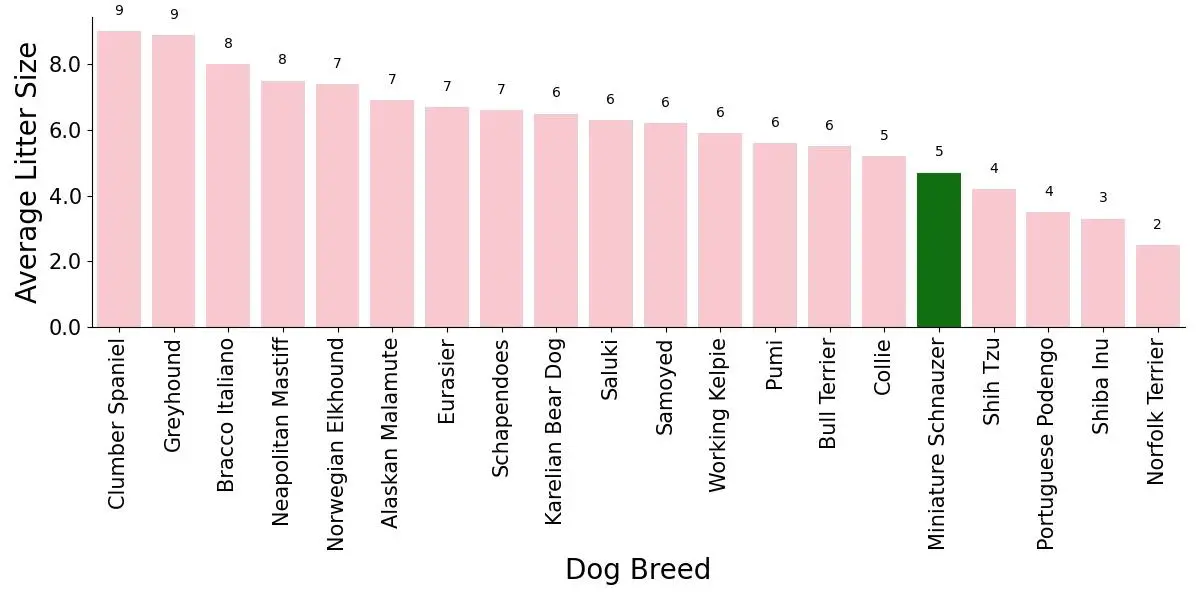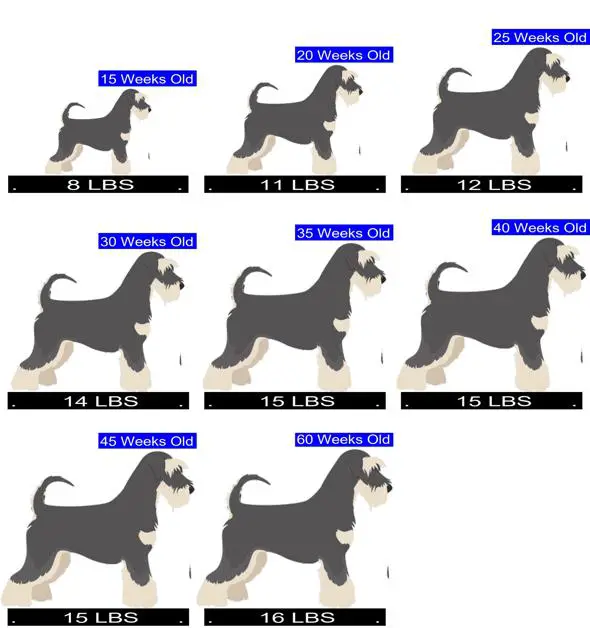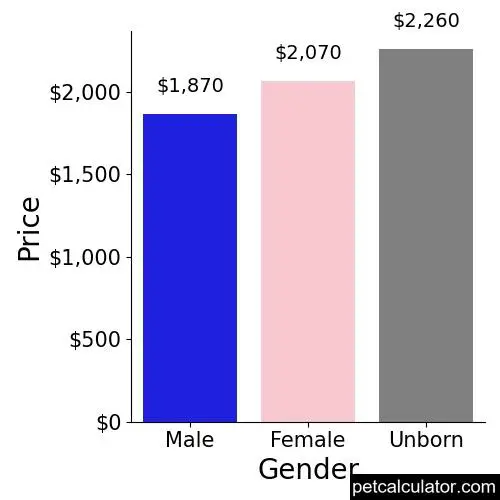Quick Links: Table of Contents
- Average Litter Size of Miniature Schnauzer
- Calculator to Predict How Many Puppies Miniature Schnauzer Will Have
- How Much Does the Miniature Schnauzer Puppy Weigh at Birth?
- How Big Will a Miniature Schnauzer Puppy Get?
- How Much is a Miniature Schnauzer Puppy
- How Long is a Miniature Schnauzer Pregnant?
- How to Ensure a Successful Pregnancy in Miniature Schnauzer
- Conclusion on Miniature Schnauzer Litter Size

Average Litter Size of Miniature Schnauzer
Researchers from the Norwegian School of Veterinary Science did a study where they counted the numbers of puppies in 205 different Miniature Schnauzer birth litters.
From this study, the researchers found that the average number of puppies that Miniature Schnauzers can have is 4 puppies. Also, the Miniature Schnauzer can have as few as 1 puppies per litter and as many as 10 puppies per litter.
See how the litter size of the Miniature Schnauzer compares to that of other dog breeds below:

Read this article to learn about how many puppies dogs have.
Calculator to Predict How Many Puppies Miniature Schnauzer Will Have
Miniature Schnauzer Litter Size Predictor
According to the result of the research carried out by researchers from the Norwegian School of Veterinary Science, the number of puppies a Miniature Schnauzer will have depends on the following main factors:
- The size of the breed (most important factor): Giant dog breeds tend to have a bigger litter size, while smaller breeds give birth to a smaller number of puppies
- The method of mating: Natural mating results in a larger litter size than artificial insemination.
- The age of the female dog: Check out the chart below to see how many puppies a female Miniature Schnauzer is likely to have at different ages.
According to research, the following factors do not affect litter size:
- The time of the year of the litter was born (season of birth): Although, from the study, litters born in the Spring seem to be larger than litters from other seasons, however, the difference was not of significance.
- The number of times a female dog has given birth in the past (known as parity): The age of the female dog is more important to the extent that it makes parity insignificant.
Based on the important factors that affect litter size, the researchers from the Norwegian School of Veterinary Science developed formulas for predicting the litter size of dogs.
We have developed the Miniature Schnauzer litter size calculator above based on their formulas. Use the calculator to predict how many puppies a Miniature Schnauzer will have based on the age, and method of pregnancy for a Miniature Schnauzer
The calculator tells you how many puppies your Miniature Schnauzer will have if your Miniature Schnauzer gets pregnant today. The calculator assumes that the length of pregnancy will be two months.
Note that we are NOT in any way encouraging you to breed your Miniature Schnauzer. Dog breeding requires expertise. If you want to be breeding dogs, get the necessary training. Also, work closely with a veterinarian when breeding a dog.
The table below shows the average litter size to expect from a Miniature Schnauzer at different ages. This table applies to a Miniature Schnauzer that conceives through natural mating.
| Age (Years) | Average Litter Size | Litter Size Range |
|---|---|---|
| 2 | 4 puppies | 3 to 6 puppies |
| 3 | 4 puppies | 3 to 6 puppies |
| 4 | 4 puppies | 3 to 6 puppies |
| 5 | 4 puppies | 2 to 6 puppies |
| 6 | 4 puppies | 2 to 6 puppies |
| 7 | 4 puppies | 1 to 7 puppies |
| 8 | 4 puppies | 1 to 7 puppies |
| 9 | 3 puppies | 0 to 7 puppies |

How Much Does the Miniature Schnauzer Puppy Weigh at Birth?
Veterinarian researchers did a study to find out how much Miniature Schnauzer puppies weigh at birth. These researchers weighed 40 Miniature Schnauzer puppies at birth.
Based on the study of the weight of 40 Miniature Schnauzer puppies, the average weight of the Miniature Schnauzer at birth is 184 grams (6.5 ounces). The birth weight of the Miniature Schnauzer puppy typically ranges from 165 grams (5.8 ounces) to 193 grams (6.8 ounces).
16 ounces equal one pound.
The factors that affect the weight of a Miniature Schnauzer puppy at birth include the size, weight, and age of the mother.
Importantly, research has also shown that female dogs that give birth at ages between 2 and 8 years give birth to puppies that are heavier than puppies birthed by younger or older female dogs.
How Big Will a Miniature Schnauzer Puppy Get?
A Miniature Schnauzer puppy will grow up to weigh around 11 to 20 pounds. Furthermore, a Miniature Schnauzer puppy will grow up to be 13 to 14 inches tall at the shoulder.
Learn more about Miniature Schnauzer weight and how big Miniature Schnauzers grow here

How Much is a Miniature Schnauzer Puppy

The average price of a Miniature Schnauzer puppy is $1950. The price of a Miniature Schnauzer puppy ranges from $1400 to $2500.
Since the Miniature Schnauzer has an average litter size of 4, therefore a Miniature Schnauzer litter birth is worth $7800.
To learn more about the price of Miniature Schnauzer puppy, check our review on how much Miniature Schnauzer puppy cost, and Miniature Schnauzer buying advice.

How Long is a Miniature Schnauzer Pregnant?
Miniature Schnauzers are pregnant for 63 days on average (2 months) after conception. However, this is an average value. The length of pregnancy in Miniature Schnauzers can range from 58-68 days.
However, note that it is difficult to know the exact day that your Miniature Schnauzer conceives because conception may not happen at the same time that mating happens.
Sperm can live inside a female Miniature Schnauzer for several days after mating before conception occurs.

How to Ensure a Successful Pregnancy in Miniature Schnauzer
To ensure that your Miniature Schnauzer successfully gets pregnant and deliver its puppies, here at the things you can do:
- Feed your Miniature Schnauzer well: A good diet will ensure that your Miniature Schnauzer has the nutrients and the energy it needs to get pregnant and maintain the pregnancy.
- Make sure your Miniature Schnauzer is in good health: Ensure you take your Miniature Schnauzer to the Vet care regularly for checkups, make sure your Miniature Schnauzer gets regular exercise. Also, make sure that your is not overweight or underweight.
To learn how to check if your Miniature Schnauzer is overweight or underweight, check out this resource.
Conclusion on Miniature Schnauzer Litter Size
Miniature Schnauzers can have 4 puppies per litter birth on average. The number of puppies that a Miniature Schnauzer will have depends on factors such as the age of the Miniature Schnauzer and the method of pregnancy (natural or artificial insemination).
Breeding Miniature Schnauzers the right way requires expertise and should be done after sufficient training.
Also, you should work closely with a veterinarian when breeding a Miniature Schnauzer. There are a lot of nuances involved in breeding a dog, which we do not have the time or the space to discuss here.
However, working with a veterinarian will ensure that your Miniature Schnauzer gets the right treatment necessary to make healthy puppies.
The litter size research study that we used for this article was conducted on Miniature Schnauzers in Norway. However, the authors of the research believe that the results can be generalized to other countries that have similar dog management systems as Norway.